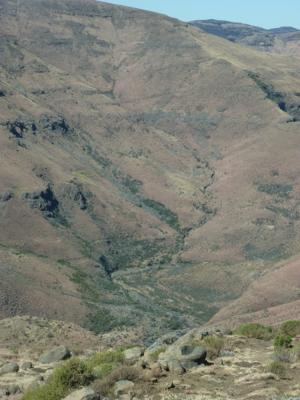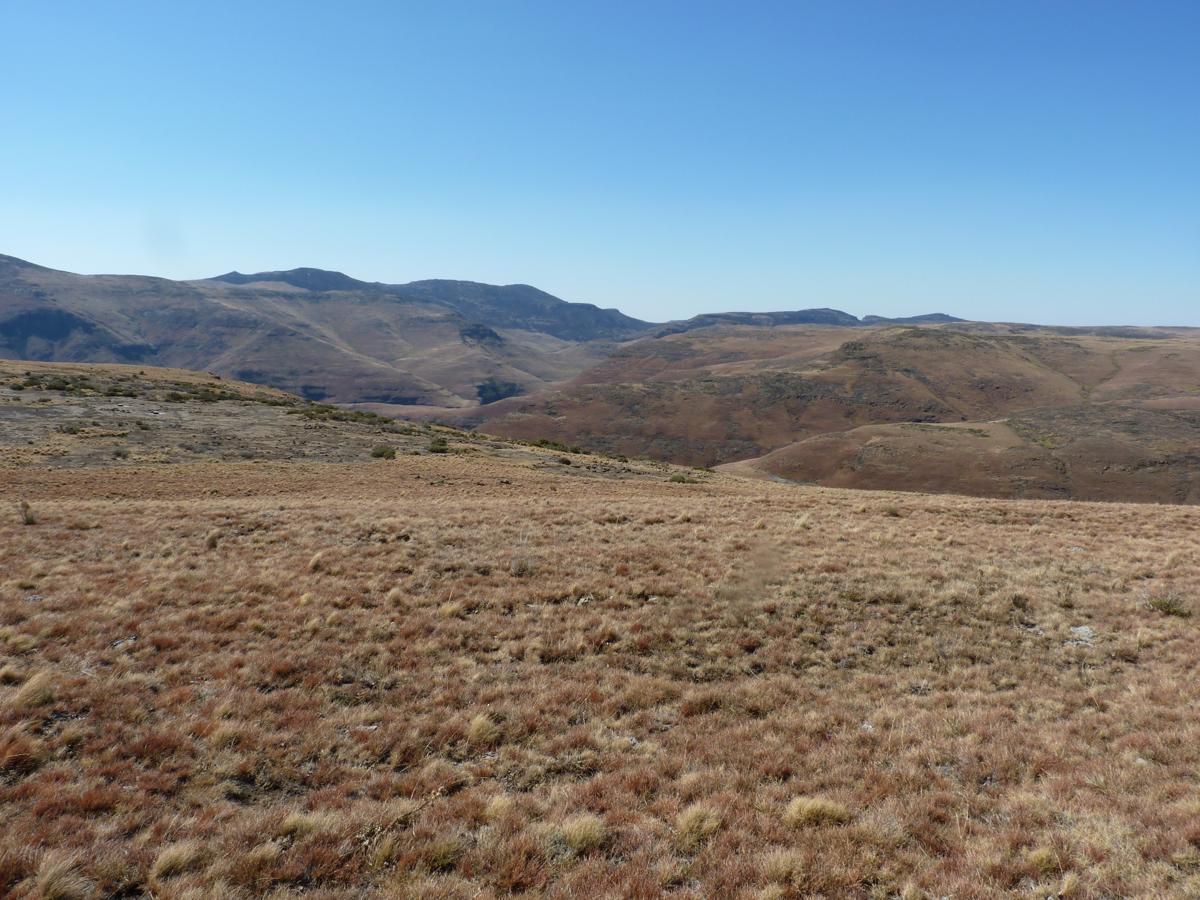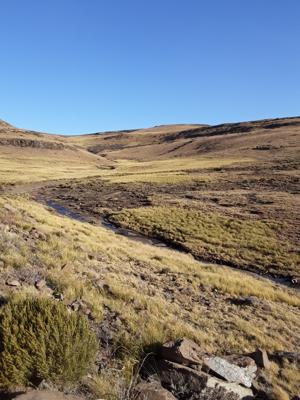
10 minute read
The Eastern Cape Highlands by Dave Walker
What is it about the Eastern Cape Highlands that has attracted many dedicated and adventurous fly fishers down the years? Although well-described by a number of aficionados in many publications, I’d like to add my five cents worth starting with a brief historical interlude.
Although unlabelled at the time, the dire impact of “global warming”, more recently referred to as “climate change”, has, in retrospect been with us for some time. For example, in the 90s, I began organising fishing festivals, the first in Barkly East and subsequently on an annual basis centred in Rhodes from 1996. These events were in December each year. It wasn’t too long before it became abundantly evident that the summer rains we had relied upon were beginning later and later each year. To avoid complete embarrassment by the dearth of early summer rain, a lack of water that became the norm, I duly shifted the event to March of each year. This has been the norm ever since but which has also been affected by climate change from time to time.
Advertisement
Ironically, the weather gods continue to interfere with what we perceived to be normal patterns, broadly speaking, spring rain followed by summer thunderstorms and approaching autumn, “geelperkse reen” and regular snowfalls in winter. Looking at rainfall records dating back to 1990 and combined with almost three decades of hindsight, annual rainfall is important but from a fishing point of view, it is when it falls that counts. The moral of the story is staying in touch on a regular basis is essential.
In very broad terms, there are three fishing zones in the Eastern Cape Highlands. Picture a dining room table set with the usual paraphernalia as well as a few taller objects; a pepper grinder, a water jug and the like being analogous peaks that characterise Zone 1. This zone consists of the plateaux along the escarpment. These are more or less easily reached depending on the presence of roads. The very upper Bell River is a fine example of the former and with the advent of the Tenahead Mountain Lodge becoming a member of the Wild Trout Association, their water is a “Lilliputianists” delight. Not often that one can go fishing at 2500m above sealevel so when the time is right, jump at the chance. Set in a valley reminiscent of the Scottish Highlands, the entire experience is wondrous, ranging from the aquatic life and extending to the terrestrial flora, animal and bird life. The stream mostly flows over bedrock that is interspersed with small plunge pools and others formed by eroded material deposited in the watercourse. Where soil banks are found, overhanging montane vegetation provides shelter for the aquatic population. Keep an eye out for undercuts found below the root level of the bankside vegetation.
At this altitude, the riverine vegetation is m o s t l y “ k h a s h u ” s i c ( M e r x m u e l l e r a macowanii ), a wiry grass that forms large tussocks. The leaf blades grow up to 650mm and have sharp tips that can make life unpleasant for folk wearing short pants. Although the calmest of days can be experienced, dealing with the wind and accurate casting are pre-requisites for zone 1 angling success where great lies for trout can be found. The residents of these lies venture out to feed on the passing aquatic and terrestrial insects such as grasshoppers that occasionally get blown onto the surface of the stream. Usually crystal clear water, trout must be stalked with the greatest of care on these waters.
Being within a short distance of the escarpment, a characteristic feature of this zone is sudden changes of weather. This can be in the form of thunder showers, dense cloud or freezing weather that is often associated with sleet, all of which can be life threatening. The Boy Scouts motto comes to mind, “be prepared” but in these climes not only should one be prepared but be observant to boot. Even though the fishing may be going well, get off the mountain before it gets you. Imagine the war stories about your almost experience while sitting in front of a fire supping anti-freeze!
For those with an appetite for alternative high altitude fishing, the still water on the Ben McDhui plateau is a must. Located around the corner from the ski resort, the water at Loch Ness, as it is known, is generally gin clear. A bonus is that the trout in this 6ha dam are all wild spawned. It has two feeder streams, one of which is miniscule, that have gravel beds ideal for the purpose. When conditions allow, they are put to good use ensuring another generation of fish to keep anglers busy. Under ideal conditions, both streams are worth a careful look and can be rewarding.
What still amazes me is that this gem is at least 25km from the nearest still water yet within a short space of time after construction, waterfowl were to be found making themselves at home on it! So, not only good fishing but a birding opportunity of note as well. A bonus is viewing the summer flowers that abound and some of which are rarely seen elsewhere. For example, one generally associates orchids with tropical forests. In reality, the species is not limited to those forests and some of which can be found “way up there” in our Alpine floral paradise.
In the journey downstream, the section between the table top and the seats of the chairs surrounding the table is the next fishing opportunity. For the purposes of this description, referred to as Zone 2. The vertical drop is generally quite sharp with waterfalls, plunge pools and more waterfalls. Typical of this zone are the waterfalls on Gateshead and, lower down, the waterfall on Brucedell with a jumbled, rock-strewn riverbed below it that flows into the next zone thereafter. The Upper Riflespruit is similar until it reaches Mt Mourne where the valley widens.
Fishing these waters is strenuous and only recommended for the fit and agile. It is rewarding for the careful - i.e. the clear water allows the prey to spot you long before you have even thought about putting a fly out! This demands a cautious approach, doubling up and stalking quietly, easing up behind rocks, using the generally vegetation-less
terrain to best advantage. It is of immense help to have a partner who can parallel your approach at a higher level along the valley to spot and offer guidance to the prey. In fact, the terrain is such that two or more fisherfolk are suggested in case of injury, especially leg injuries that may render one immobile!
Access to Zone 2 is not easy and more often than not, one has to literally has to reach the end of the road before embarking
on the hike upstream to savour the delights of such water.
Then downstream of the analogous chair “seat-level” is Zone 3 where the terrain idles down to the analogous chair’s side or cross stretcher level. This section is less steep with far gentler gradients. It is typified by deep soil banks, plenty of plant growth and a meandering course. The sinuous curves, bends and loops create great lies. These can generally be explored with success using the flow to swirl a well-presented fly into a prime position to lure a wary trout out of its safety zone. The Working for Water crack willow destruction programme has left many kilometres bereft of trees. Fortunately or unfortunately, depending on your view, the operation was predictably less successful in the less accessible places. Trees, their roots and the residual dead trunks in the water all add to the structure and accordingly provide shelter not only to trout but also to the other aquatic inhabitants including indigenous species. More often than not, the currently used and seemingly popular light tackle militates against exploring such trout hotels but so be it. There are choices.

Beats in this zone are easily reached as roads in the Highlands are mostly along the valley floor parallel to the water course. The environment is naturally more productive in terms of the food resource so bigger fish can be taken. An example of this type of environment would be from Bothwell on the upper Bokspruit down to Jennerville on the lower Sterkspruit. In the case of the former, two to three pounders and six or seven pounders have been enticed out of their lairs on the latter beats. Fishing these waters is often as challenging as the upstream beats as it can be clear but is occasionally “off colour” which can also be advantageous. A spotter is also recommended but with fewer elevated positions being a limitation on this practise.
An interesting aside is that when a “gillhooked” fish succumbs to a priest, the flesh from the first two zones is generally “white” or hake-like. Those of the lower climes is orange, thanks to the much higher crustacean

population and consequent natural contribution to their diet. Commercial trout fish farm pellets include carotene to mimic Mother Nature in colouring the flesh of their product in a similar fashion!
The scenic splendour of the Highlands is almost indescribable. Trying to capture it on camera can be a frustration as the lenses seem to be too small to do justice to the view. Geomorphological features abound, some of which are not found around every corner but are there nonetheless. One such feature is a protalus rampart. Described as being an overblown name for a simple landform, it is the product of eroded material that falls from a cliffs onto steep snow banks. It slides down the slope and accumulates at the base. When the snow melts, it leaves a mound or mounds that vary in height and width depending on local circumstances at the time. An example of one is to be found at the top of the Bastervoetpad Pass on beginning the descent. Another is to be found in the Bokspruit but is not easily reached.
For those of an entomological bent, a species of hoverfly (Pelloloma nigrescens), one of over 6000 different species found around the world has ever been found near the top of the Naudesnek Pass. The Alpine flora is also noteworthy, one of which, Eucomis grimshawii is only found in a small area in the Ben McDhui basin where the ski resort is located as is Felicia caespitosa. The list is almost endless but could be severely truncated by adverse agricultural practises.
The birdlife in the form of, amongst others, the Bearded vulture (Gypaeteus barbatus) that was once abundant and is now listed as near threatened, is very special indeed. +-230 species have been recorded in the Barkly East district. There are seasonally migratory species such as Malachite sunbirds (Nectarina famosa) but of those who stick it out throughout the year, the Greywing francolin (Francolinus africanus) is one of my favourites. Living above the snowline takes some doing. During the winter months, they survive on nutgrass (Cyperus rotundus). The name, however, has nothing to do with nuts that are, in fact, tubers that have a somewhat nutlike appearance. These “nuts” although bitter-tasting have both medicinal antibacterial and nutritional properties. They are also high in carbohydrates and a source of minerals and trace elements. Although referred to as “scratchings” they dig out the “nuts” using their beaks only and the story behind the “favourite” story will have to wait for now as will descriptions of several other outdoor attractions!
Having digressed somewhat, a swerve back to the piscatorial pursuits is along the lines of the fine fishing that can be had but one must make use of local sources of information before making the pilgrimage. Images of the Eastern Cape Highlands that one sees in the media are stunning, reflecting conditions at the time they were taken but which can and most certainly do change. Local is lekker and staying in touch to keep up to date is essential. The cost of a call is way less than the cost of the fuel to get here!

For more information: Rhodes Tourist & Information Centre +27 (0)45 971 9003 contact@wildtrout.co.za Dave Walker +27 (0)45 974 9290 dave@wildtrout.co.za










